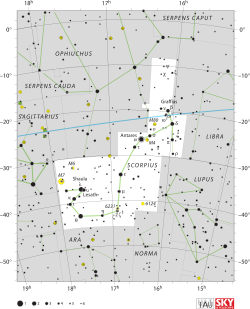Pi Scorpii
| Observation data Epoch J2000 Equinox J2000 |
|
|---|---|
| Constellation | Scorpius |
| Right ascension | 15h 58m 51.11324s |
| Declination | –26° 06′ 50.7886″ |
| Apparent magnitude (V) | 2.890 |
| Characteristics | |
| Spectral type | B1 V + B2 V |
| U−B color index | –0.918 |
| B−V color index | –0.187 |
| Variable type | Eclipsing binary |
| Astrometry | |
| Radial velocity (Rv) | –3 km/s |
| Proper motion (μ) |
RA: –11.42 mas/yr Dec.: –26.83 mas/yr |
| Parallax (π) | 5.57 ± 0.64mas |
| Distance | approx. 590 ly (approx. 180 pc) |
| Orbit | |
| Period (P) | 1.570103 ± 0.000005 d |
| Semi-major axis (a) | ~0.07 AU |
| Eccentricity (e) | 0.0 |
| Inclination (i) | ~42° |
|
Semi-amplitude (K1) (primary) |
124.1 ± 1.5 km/s |
|
Semi-amplitude (K2) (secondary) |
196.1 ± 1.8 km/s |
| Details | |
| π Sco A | |
| Mass | 12.5 ± 0.6 M☉ |
| Radius | 5 R☉ |
| Luminosity | 21,900 L☉ |
| Temperature | 25,230 K |
| Rotation | 100 |
| Rotational velocity (v sin i) | 108 km/s |
| Age |
15.4 ± 0.6 12-14 Myr |
| π Sco B | |
| Radius | 4 R☉ |
| Rotational velocity (v sin i) | 87 km/s |
| Other designations | |
| Database references | |
| SIMBAD | data |
Pi Scorpii (π Sco, π Scorpii) is a triple starsystem in the southern constellation Scorpius. With a combined apparent magnitude of 2.9, it can be easily seen with the naked eye. Parallax measurements yield an estimated distance of around 590 light-years (180 parsecs) from the Earth.
The name Pi Scorpii was assigned to this star by the German astronomer Johann Bayer in 1603. In 1712, it received the catalogue identifier 6 Scorpii with the publication of the star catalogue of English astronomer John Flamsteed. The binary nature of this star remained unknown until 1899, when it was announced by American astronomer Edward Charles Pickering. Two years later, an orbital period of 1.571 days was found by American astronomer Solon Irving Bailey, but it would not be until 1927 that the orbit of this spectroscopic binary was determined by Russian astronomer Otto Struve and American astrophysicist Christian T. Elvey.
The main components of this system form an eclipsing binary of the Beta Lyrae type. Both its members are hot, B-type main sequence stars with a blue-white hue. They display an ellipsoidal variation of 0.03 in magnitude. The two stars are rotating rapidly, with projected rotational velocities of 108 and 87 km s−1, respectively. Their orbital period is 1.57 days and they are separated by an estimated distance of only 15 solar radii along a circular orbit. The binary system is orbited by a smaller, more distant companion, which has an apparent magnitude of +12.2. This component is separated from the pair by 50 arcseconds, putting it at least 7000 astronomical units away.
...
Wikipedia

